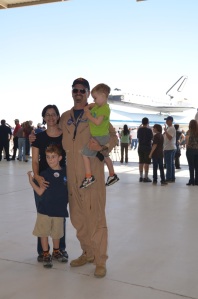 We finally made it to the California Science Center to view Space Shuttle Endeavour, the youngest in the Space Shuttle fleet. The boys were sick when Nils signed autographs at the Science Center Halloween weekend, when the exhibit first opened. Nils flew one of the aircraft that chased Endeavour and the 747 on its trip to LAX in September. He carried a NASA flight photographer in his back seat.
We finally made it to the California Science Center to view Space Shuttle Endeavour, the youngest in the Space Shuttle fleet. The boys were sick when Nils signed autographs at the Science Center Halloween weekend, when the exhibit first opened. Nils flew one of the aircraft that chased Endeavour and the 747 on its trip to LAX in September. He carried a NASA flight photographer in his back seat.
On a rainy Saturday morning, the Science Center was crowded. Endeavour was doing its job of drawing people into the museum, which made me happy. We are frequent visitors, and I’ve never seen the place so packed.
To see Endeavour, you must obtain free, timed tickets. You can get these at the museum, though you risk them selling out, or you can print them at home or a $2 per ticket fee. When we arrived at 10 a.m., the only available tickets were for 3 p.m. Because the Science Center itself is free, it’s well worth it to print your tickets at home.
Your ticket admits you first to the “California Story” exhibit, which details the Shuttle’s birth in Palmdale, California. Viewers can touch the tires Endeavour used on its last flight. They can see a real space potty and kitchen and watch videos about how they work. These two topics are always a hit with kids, and astronauts will tell you they probably answer questions about eating and going to the potty in space most often.
There is also a mock-up of Rocketdyne’s operation support facility, which looks a lot like mission control. There you can watch and hear a launch on the screens.
For me, the time-lapse video showing Endeavour’s flight into Los Angeles and 48-hour trip through town to the museum was a highlight. The number of people who turned out for this historic event is overpowering. The video also highlights the contrast between this one-of-a-kind asset and the everyday of Los Angeles with views of Endeavour through a laundromat window, shots of it driving through streets lined with houses and , images outside a donut shop.
From the exhibit, you head to the Samuel Oschin Pavilion, a temporary home for Endeavour until a new building is built. Many years ago I saw Space Shuttle Atlantis in major modifications at Palmdale, and I’m not sure I’ve ever been so close. Visitors can almost touch the heat-resistant tiles. The Pavilion also is home to SPACEHAB, which the Shuttles carried to provide extra space to live and work, as well as a Space Shuttle main engine. There are video clips highlighting Endeavour’s missions. The outside wall provides details about each Space Shuttle mission.
You can stay in the exhibit as long as you like. If you can, go earlier in the day, because the line backs up and the exhibit gets crowded as the day moves on. And while you are there, don’t miss the EcoSystems exhibit and all the children’s discovery rooms.

 Space Shuttle Endeavour came home to California today, and we were able to join the festivities. Endeavour, like all the orbiters, was born in Palmdale, California. Endeavour is the “baby” of the now-retired fleet, first flying 20 years ago.
Space Shuttle Endeavour came home to California today, and we were able to join the festivities. Endeavour, like all the orbiters, was born in Palmdale, California. Endeavour is the “baby” of the now-retired fleet, first flying 20 years ago.
 This weekend we took the Curious Kids to the
This weekend we took the Curious Kids to the 


